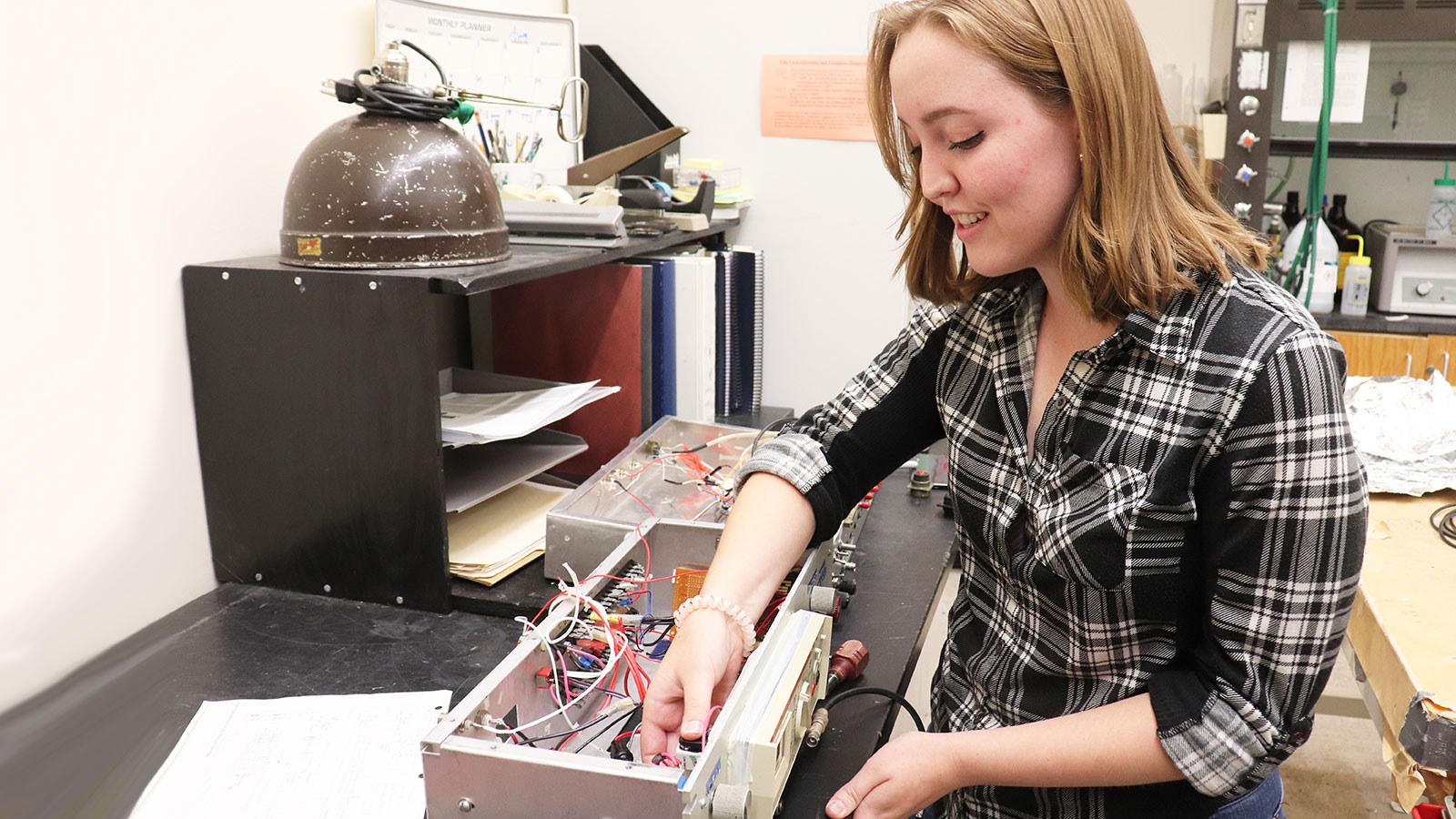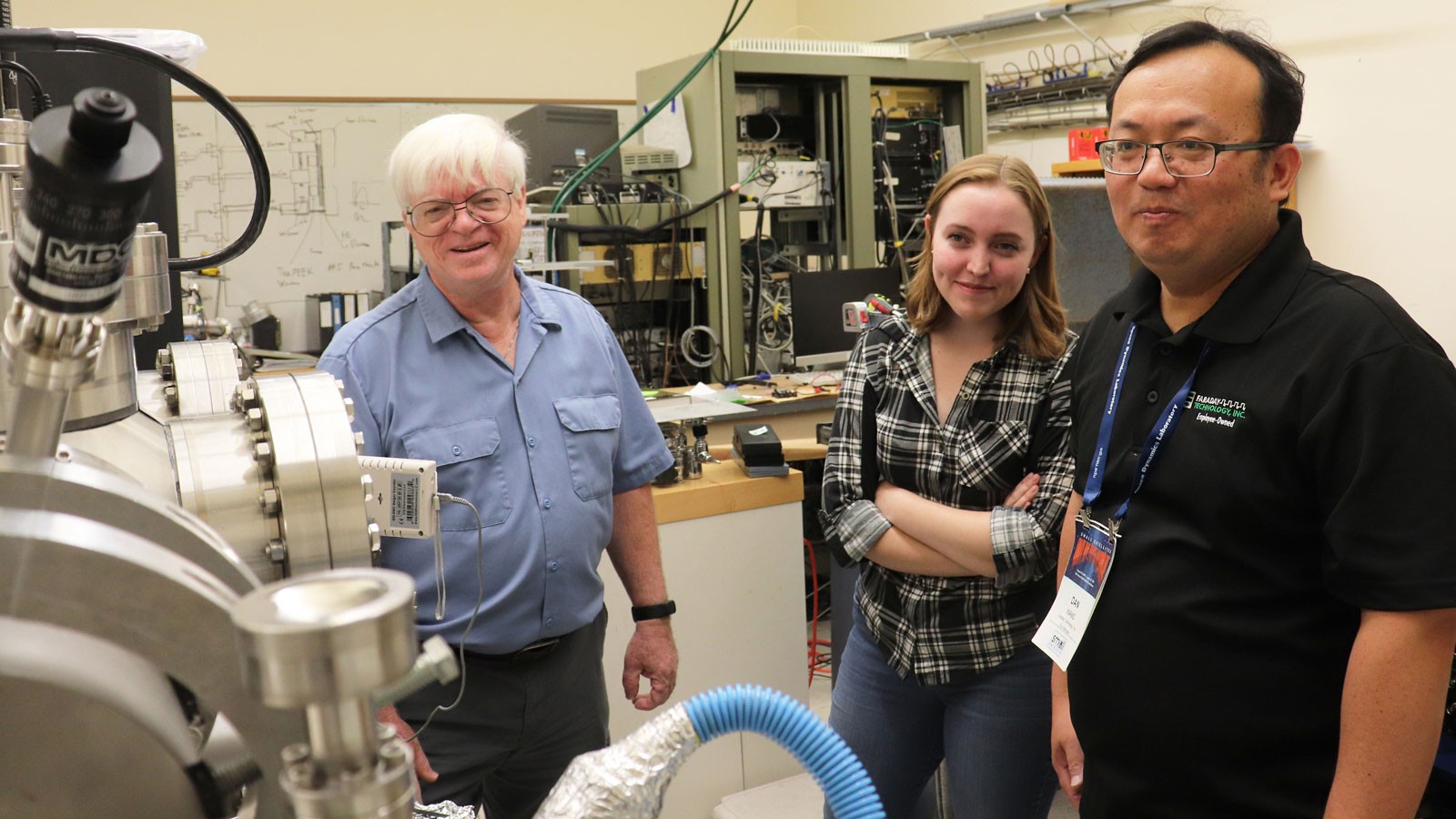Shooting for the Moon: USU Peak Fellow Conducts Material Physics Research
Undergrad researcher Heather Allen is developing tools and techniques to study lunar dust
By Mary-Ann Muffoletto |
In a USU Physics lab, undergrad researcher Heather Allen adjusts the control unit of an electron flood gun she's built to study simulated lunar dust. Allen is among USU’s 10 2022 Peak Summer Research Fellows. (Photo credit USU/M. Muffoletto)
Physics wasn’t Utah State University scholar Heather Allen’s favorite class in high school. But a lecture on Einstein’s field theory captured her rapt attention.
“I was wide awake while my classmates were dozing off,” says Allen, who graduated from Utah’s Lone Peak High School in 2019.
The Pleasant Grove native chose USU after hearing of the university’s prowess in aerospace and mechanical engineering, and considered several majors. After spending time in the Materials Physics Group lab of USU Professor J.R. Dennison, she chose physics as her major, with minors in mathematics and computer science.
“After working in J.R.’s lab, I was sold on physics,” says Allen, who is a 2022 Peak Summer Research Fellow and a past Undergraduate Research and Creative Opportunities grant recipient. “I like experimental work and the problem-solving aspects of research.”
Her current research focuses on making electron yield measurements of granular samples simulating materials flown in space and determining how this information can influence spacecraft design. She hopes to someday work with actual lunar dust to help characterize its electrostatic properties.
“The astronauts who landed on the Moon had lunar dust in their suits, in their equipment, in their lungs,” Allen says. “The dust is an irritant and health hazard, but its electrostatic properties can also damage electronic components and build up into dangerous electric shocks and explosions.”
Until she can work with actual lunar material, Allen conducts research with aluminum oxide, a major component of the gritty moon particles.
“Lunar dust particles are abrasive and angular, and I’m working with samples that simulate these particles and range in size from 0.1 to 120 microns,” she says. “We’re working on the best methodology to collect samples and demonstrating how data can be extracted from these samples.”
To do this, Allen has developed, from scratch, skills ranging from machining and electrical engineering to computer programming.
“It was intimidating at first,” she says. “I’d never set foot in a machine shop and I didn’t know how to build electrical circuits. I learned LabVIEW, a graphical programming language, by toughing it out with the manual.”
With persistence and learning to ask for help, Allen has mastered a range of skills to support her research.
“I built a crude electron gun to use in a vacuum chamber to expose material samples to a simulated space environment,” she says. “Having to design and build research equipment piece by piece has helped me understand every physical aspect of my project’s experimental design. It’s been a challenge, but I feel more ready to take on new projects, as well as graduate school.”
Among the new projects her mentor, Dennison, is urging her to consider is a study of graphite as part of a potential collaboration with Faraday Technology, a Dayton, Ohio-based electrochemical technology firm.
“Graphite, which is lightweight, strong and widely used for aerospace components, is interesting because it’s a carbon allotrope and carbon is non-metal,” Allen says. “Graphite is described as a ‘semimetal;’ it’s both a conductor and an insulator.”
As a Peak Fellow, Allen has spent the summer participating in varied training and workshops with fellow science and engineering students, as well as the university’s Caine Summer Arts Fellows, who are arts and humanities majors.
“I’ve been so focused on physics and STEM in general, it’s been good getting different perspectives from other disciplines,” she says. “I’ve also appreciated receiving advice beyond research, including how to prepare a resume and for interviews, how to be part of a team and how to communicate research. I’m grateful to Drs. David and Terry Peak for creating the fellowship along with other student opportunities.”
Allen is a recipient of the O. Harry Otteson Award, given to the USU physics student achieving the highest grade in introductory physics, and also received the Farrell and Ann Edwards Endowed Scholarship and the Outstanding Student Presentation Award at the American Physical Society’s regional Four Corners Meeting. She was also a USU Goldwater Scholar nominee.
Allen advises all undergrads to get involved in research.
“It takes learning to a higher level,” she says. “And J.R. has been the best mentor you could ever ask for.”
From left, Physics Professor J.R. Dennison, Peak Fellow Heather Allen and Dan Wang of Faraday Technology, Inc. examine a vacuum chamber at USU. The scientists are considering a collaborative research project. (Photo credit USU/M. Muffoletto)
WRITER
Mary-Ann Muffoletto
Public Relations Specialist
College of Science
435-797-3517
maryann.muffoletto@usu.edu
CONTACT
J.R. Dennison
Professor
Department of Physics
435-797-2936
jr.dennison@usu.edu
TOPICS
Undergraduate Research 157stories Space 140stories Physics 99storiesComments and questions regarding this article may be directed to the contact person listed on this page.









